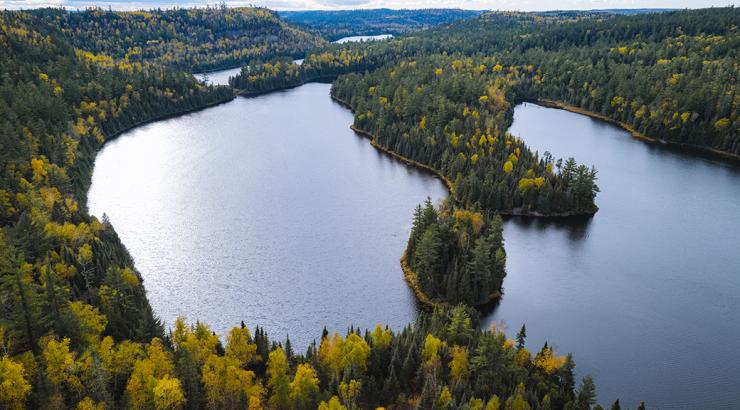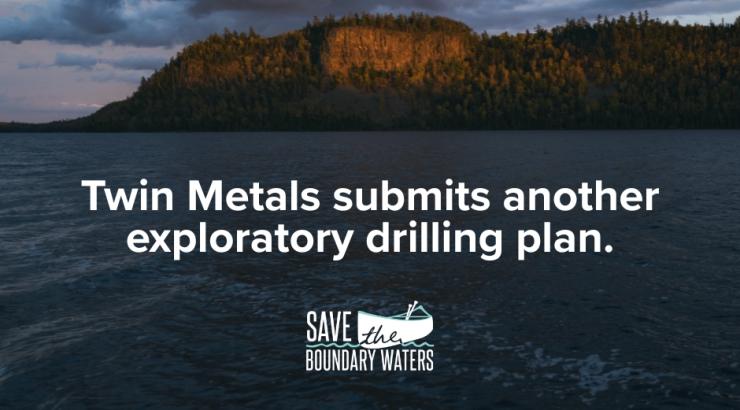The January 26, 2023 decision by Interior Secretary Deb Haaland to ban sulfide-ore copper mining on 225,504 acres of Superior National Forest land upstream of the Boundary Waters is a historic win for Boundary Waters protection. You were a big part of this win, speaking up for this quiet place time and time again. Thank you.
However, the Boundary Waters is a forever wilderness, and the Campaign to Save the Boundary Waters will work until we gain permanent legal protection from this toxic industry on federal and state land.
In 2023, in addition to litigation, outreach, and other advocacy programs, we are advancing two critical pieces of legislation, one state bill and one federal. Both bills would permanently ban sulfide-ore copper mining on public lands in the headwaters of the Boundary Waters. What you can do for the Boundary Waters:
- Thank Secretary Haaland and the U.S. Forest Service for their science-based, publicly supported decision.
- If you live in Minnesota, contact your state legislators and urge them to support the Boundary Waters Permanent Protection bill
- Contact your U.S. members of Congress and urge them to support Rep. McCollum’s Boundary Waters Protection and Pollution Prevention Act, HR 668.
Want to know more about the recent decision?
On January 26, 2023, a 20-year mining ban was issued for the federal lands and minerals in the watershed of the Boundary Waters Canoe Area Wilderness. The Public Land Order, also known as a “mineral withdrawal,” protects the Wilderness from risky sulfide-ore copper mining on 225,504 acres of federal lands in the Superior National Forest upstream of the Boundary Waters.
The Public Land Order comes after a comprehensive scientific study by the U.S. Forest Service that found that sulfide-ore mining would pollute the Boundary Waters and that pollution could not be fixed or mitigated. The final Environmental Assessment was released on January 26, 2023.
It’s critical to celebrate this historic win for the Wilderness, and thank the leaders who are protecting the Boundary Waters. Take 30 seconds and sign our thank-you card to Secretary Haaland and the U.S. Forest Service today.
This mining ban is the most significant achievement for Boundary Waters protection and for land conservation in Minnesota since 1978.
What led us to this victory?
You may recall we worked hard to achieve this federal 20-year copper mining ban. We began our advocacy ten years ago, during the Obama Administration. In January 2017, the Forest Service applied for mineral withdrawal of public lands in the Boundary Waters watershed. Unfortunately, despite our efforts, this first application was canceled by the Trump Administration in September 2018, and the preliminary environmental assessment was blocked from the public. Nevertheless, we continued with our strong advocacy, leading with science and supported by dedicated individuals and organizations that took the case to the public and policymakers.
In October 2021, the Forest Service released a new application for a federal mineral withdrawal of Superior National Forest lands in the watershed of the Boundary Waters. It is this application that is the basis for Secretary Haaland’s Public Land Order banning sulfide-ore copper mining on federal lands upstream of the Boundary Waters, Voyageurs National Park, and Quetico Park.
Science
The science is clear. Sulfide-ore copper mining in the headwaters of the Boundary Waters would forever change the ecosystem and the landscape of the Wilderness, resulting in degraded water and air, noise pollution, loss of habitat and wildlife, light pollution, and damage to the regional amenity-based economy and tax base.
Unlike iron ore or taconite mining, sulfide-ore copper mining has never been developed in the state of Minnesota. This type of mining generates waste rock full of sulfates, sulfides, and heavy metals. The sulfates, when exposed to air and water, become sulphuric acid and leach toxins like sulfides and heavy metals into the surrounding water. This destructive industry should not be allowed in the headwaters of the Boundary Waters, where over 165,000 people paddle, fish, and swim each year.
The U.S. Forest Service’s Environmental Assessment (EA) is the comprehensive study used to determine the environmental benefits of a mineral withdrawal and the likely negative impacts and degradation posed by sulfide-ore copper mining in the Boundary Waters headwaters. It notes that the Boundary Waters is a complex and interconnected ecosystem that offers recreational opportunities and other uses such that it is considered an irreplaceable national treasure.
The EA echoes what many of us have been saying for years: the Boundary Waters should not be put at risk by upstream toxic sulfide-ore copper mining. While there is still work to be done, the Environmental Assessment and 20-year mining ban make this a turning point in the fight to permanently protect the Boundary Waters.
Public support
In January of 2022, the Campaign to Save the Boundary organized partners and the public to submit over 250,000 comments supporting the 20-year ban to the U.S. Forest Service during a 90-day comment period. This huge number of comments eclipses the 181,000 comment mark from a prior federal application in 2017.
You helped us achieve this critical victory. Thank you for speaking up for this quiet place!
It’s clear that protecting the Boundary Waters is popular. In fact, polling shows that nearly 70 percent of Minnesotans support permanent protection for this priceless Wilderness area, and a vast collection of peer-reviewed science shows that if the Twin Metals mine was built along the rivers and streams flowing into the Wilderness, pollution and environmental degradation would be certain.
Looking ahead
Protecting the Boundary Waters from a giant foreign mining conglomerate with terrible environmental and human-rights records takes a lot of hard work. 2023 is sure to be a busy year for the Campaign to Save the Boundary Waters, and will include:
Legislation:
The Boundary Waters watershed includes both state and federal land, all of which is vulnerable to sulfide-ore copper mining interests. Thus, common-sense legislation on both the State and Federal level is required - companion legislation that forever bans sulfide-ore copper mining on these vulnerable lands immediately upstream of the Wilderness.
- State Bill: In January, the Boundary Waters Permanent Protection Bill (S.F. 167/H.F. 329) was reintroduced in the Minnesota Senate and House by authors Senator Kelly Morrison and Representative Sandra Feist. The bill prohibits both sulfide-ore copper mining on state land and issuance of sulfide-ore copper mining permits, licenses, and leases within the headwaters of the Boundary Waters Canoe Area Wilderness. Contact your Minnesota elected officials!
- Federal Bill: On January 31, U.S. Congresswoman Betty McCollum re-introduced her Boundary Waters Protection and Pollution Prevention Act (HR 668). This legislation permanently bans sulfide-ore copper mining on federal lands within the watershed of the Boundary Waters Canoe Area Wilderness. Our ultimate goal is to achieve permanent protection of the Boundary Waters, and that is feasible through the passage of legislation by Congress and signature by the President. The reintroduction of this bill by Rep. McCollum is a critical first step. Contact your Federal elected officials!
Litigation:
- Minnesota Environmental Rights Act (MERA) Lawsuit: Northeastern Minnesotans for Wilderness, leader of the Campaign to Save the Boundary Waters, brought a lawsuit challenging Minnesota’s non-ferrous mining rules, filed pursuant to the Minnesota Environmental Rights Act (MERA) on June 24, 2020 (for details, see NMW's January 20, 2021 Amended Complaint). NMW alleges that the current mining rules - adopted 30 years ago - fail to protect the Boundary Waters and its watershed. The current rules allow for sulfide-ore copper mining in the upstream half of the Rainy River-Headwaters watershed, next to and outside of the Wilderness. Sulfide-ore copper mining in this area would harm wildlife and air quality, destroy the scenic and recreational values of the most popular recreation lake in the area outside of the Wilderness, and send water pollution flowing directly into the Boundary Waters and adjacent protected areas including Quetico Provincial Park and Voyageurs National Park. Per an order by District Court Judge Patrick Diamond, the Minnesota Department of Natural Resources must render its decision on or before May 31, 2023, as to whether Minnesota’s current non-ferrous mining rules are adequate to protect the Boundary Waters. Following the DNR's decision, it is likely there will be further proceedings, including a contested case hearing and potentially a rulemaking to amend the nonferrous mining rules.
- Federal Litigation: On December 22, 2022, NMW, ten area businesses, and four conservation groups moved to intervene on the side of the federal government against a Twin Metals lawsuit that seeks to force the renewal of terminated leases next to the Boundary Waters Wilderness. In addition, the businesses, NMW, and conservation groups moved to dismiss Twin Metals’ lawsuit.
Our multi-pronged strategic approach includes science and research, diversity & equity, education, grassroots mobilization, and much more!


